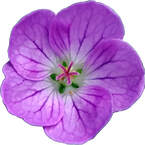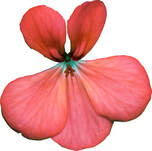Geranium or Pelargonium
|
The plant commonly called a 'Geranium' is actually a Pelargonium.
When these plants were first brought to Europe from South Africa it was thought they were the same as the European Geranium. It was later found that, though they do share many similarities, they differ in several ways. The 'new' plants were re-classified as Pelargoniums, with both the Geranium and the Pelargonium classified as genera of the Geraniaceae Family. The original (incorrect) classification persists. Nurseries tend to label these plants as Geraniums because this is what most people recognize them as. True Geraniums are known as Cranesbills, which refers to the shape of the seedpod. |
|
Geraniums have:
|
|
Pelargoniums were so named because the seedpods resemble the beak of a stork. (Pelar means stork).
|


